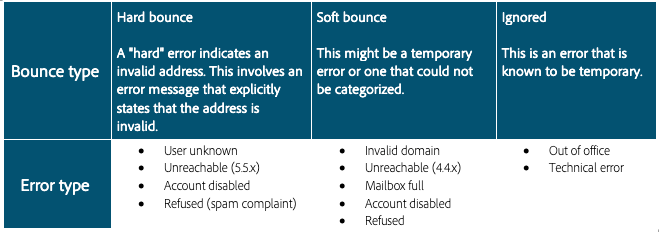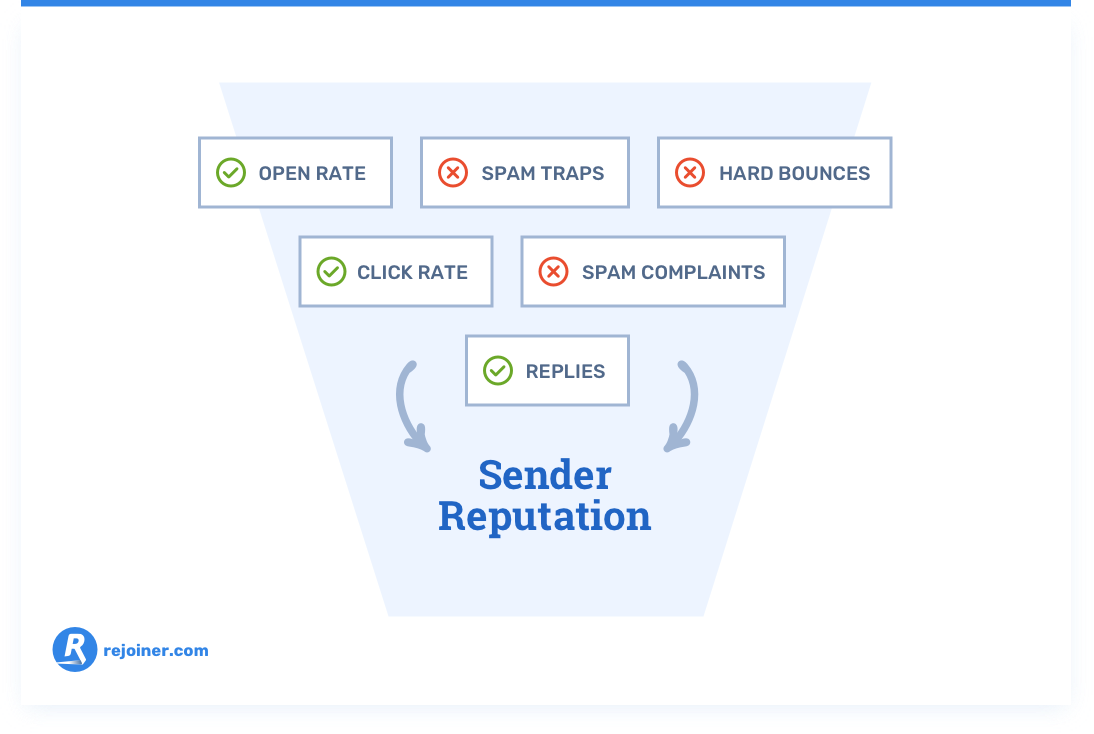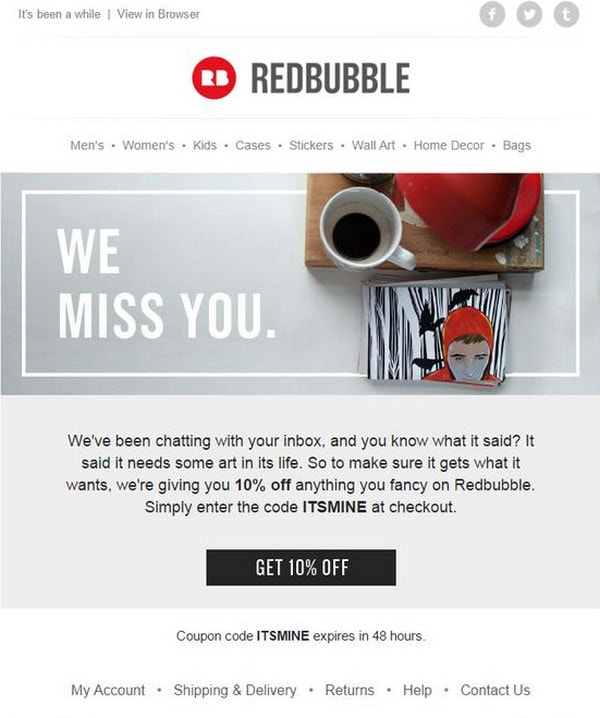If you want to use email marketing to advertise your business, it’s important to understand email hygiene, how to conduct it, and why it’s so important.
While it might seem like an easy task for marketers to manage at first glance, it can get more complicated than you might realize if healthy practices are not maintained.
What is email list hygiene?
Email hygiene refers to keeping an email list that is up-to-date and of the best quality. This will usually mean removing any email addresses that are out of date or no longer working. To do this successfully, marketers need to first understand the difference between email hard and soft bounces.
Hard bounces occur when email addresses no longer work, for example, when an employee has left a business and no longer has that work email address, or when somebody closes down their email account.
On the other hand, a soft bounce occurs when the email still works, but the system sends back a response, for example, an out-of-office response or a message to inform you that your email is not recognized.
Hard bounces are the main issue to worry about since these emails are no longer existent or not in use. Getting too many hard bounces will impact your sender score, which can reduce your deliverability rate, resulting in your emails not being received by other subscribers.
Along with this, keeping these addresses on your email list by not practicing good list hygiene can also be a significant expense to a business since more of the time, companies pay per so many sends.
If you have a large number of bounces, are ending up in more spam filters than you would like, or have low open and click-through rates, it’s a sign that you may need to address poor email list hygiene and improve your sender reputation.
Email list hygiene solutions to consider
If you want to improve your sender reputation and start working on your email hygiene, there are a few practical ways to get started. Here are the two we suggest doing first.
Remove hard bounces and test soft bounces
The most basic solution that many automated tools do on your behalf is to remove hard bounces and test soft bounces. Hard bounces should no longer be on your list and should be removed immediately.

However, don’t stop there – it’s worth trying to find out more about why the hard bounce has occurred. For example, if it was a work email address, who has replaced that person, and can you update your record?
On the other hand, soft bounces should not be such a cause for concern. They are still relevant, however, you know that these emails are not being opened, so it’s important to consider how you can re-engage them.
For example, you can run a re-engagement campaign to a list of email addresses that have stopped opening and clicking through on your emails. This can be an effective email strategy for your email list health – send a few emails asking those subscribers if they even want to be on your lists anymore.
If they don’t reply, those are unengaged email addresses that you can and should remove to decrease your email deliverability issues.
Personalize your messaging
With so many brands using email marketing today, it’s never been more important to stand out in the clutter and engage your target audience with personalized messages. Not only is it important to personalize your content, but also knowing when to personalize it is also crucial. Make it easy for subscribers to provide you with data that you can use to do this.
For example, you can ask them to sign up using basic information such as their name and email address. Then, once your subscribers have a better understanding of the products and services that your company offers, you can send out surveys to find out more about them.
Why email list hygiene is important
Email list hygiene is considered to be one of the most important aspects of a successful email marketing campaign. It involves cleaning out any inactive subscribers from future email campaigns and making sure that your list only includes active subscribers.
Regular email hygiene will help you make sure that you are only sending emails to people who want to receive messages from you, which helps you avoid your messages from being marked as spam.
This is important as email service providers are getting smarter and more in tune with what their users actually want to receive in their inboxes. Because of this, having a clean email list has never been more important when it comes to making sure that your emails are actually delivered and opened.
ESPs are paying more attention to the emails that you are sending and how they are being engaged with. ESPs do not only look out for spam signs and monitor spam complaints, but they will also calculate opens, clicks, inactivity, and unsubscribes to decide whether a message gets through to the inbox or is sent straight to spam.
Permission to send marketing emails does not mean that you are immune from the need to practice good email hygiene. It’s important to bear in mind that this consent will not last forever, so once a subscriber opts in to receive your content, you need to monitor and track their behavior over time to make sure that they are removed from your list if they become more of a liability than an asset due to losing interest.
Email data hygiene and your sender score
Your sender score refers to how you are viewed as a sender by ESPs. To determine this, various factors are taken into account including engagement, spam complaints, bounce rate, open rate, and more.

Having too many emails marked as spam can damage your sender score and affect your email data hygiene. Then, it is harder for you to reach other subscribers or even see your address put on a block list.
The health of your email list matters just as much as the emails that you send. A clean list with proper email list hygiene habits means that your emails are far less likely to be marked as spam, as ESPs will see that you are sending to engaged subscribers.
This refers to any kind of engagement with your email including opens and clicks, recent opt-ins, recent purchases of products and services, replies, or adding you as a contact, all of which signify to ESPs that these subscribers want to hear from you.
Email list hygiene best practices
Email list management requires a clean list to be effective. With over twenty percent of email signups containing spelling mistakes, domain errors, and syntax errors, a clean list is necessary to form the foundation of all personalized email marketing.
Cleaning frequency
There are a few best practices to follow when it comes to email list hygiene. Ideally, you should always have a clean email list, which is not always easy to maintain considering that B2B email data decays at a rate of around 22% per year.
Verify your email list based on the size of your company. It’s recommended that small and medium businesses clean their email lists around once per month using a tool that gets the best results. Larger companies may need to clean their email lists even more frequently.
Removing invalid email addresses is actually not that difficult if you use a reliable email validation tool such as Bouncer. With Bouncer, you can scan lists of email subscribers as big as 100,000 and more and get results within minutes.
👉 Read more: How to clean up an email list?
Correct duplicates
Duplicate email addresses occur when there are multiple entries for the same person in your database. If your list isn’t clean, this could lead to errors such as the same person being segmented into different groups. When only one message is targeted, this could lead to the subscriber not opening the right one, and it also looks unprofessional on the part of the business.
The problem is, most email marketing platforms won’t catch duplicates on your email contact list, so you’ll have to do it manually or with email list cleaning services such as Bouncer.
Remove unengaged recipients
While it can be tough to remove the data of leads that you worked hard to get, it’s always best to clean your email list of inactive subscribers who have never engaged with your business. Even if you have a list of contacts that is accurate and complete, email hygiene should take things further by removing any contacts that just aren’t interested.
There are always going to be subscribers who have never opened an email from you and probably never will; continuing to send messages to inactive subscribers is only going to increase the risk of damaging your sender score over time.

Email list marketplace hygiene concerns
Prioritizing email list hygiene right from the start will help you increase your email deliverability rate, build, and maintain a strong sender score, and prevent your emails from ending up in spam folders, ultimately building more engagement with your subscribers, establishing trust, and converting leads to customers.
Buying email lists from marketplaces can be a tempting way to increase your email list when you are first starting out or moving your business into a new market. However, there are some hygiene concerns to consider.
Most of the time, email lists that you can purchase are of poor quality, and there are privacy concerns as the subscribers will not have consented to be contacted by you, which can immediately cause your emails to be marked as spam.
Along with this, you cannot always be sure that an email list purchase from a marketplace contains only correct data.
If you are considering using an email list marketplace, there are several best practices that you should always keep in mind including only using high-quality, reputable email providers. Also, it’s recommended to run the list through a verification program before sending any messages to remove any misspelled, invalid, or inactive emails.
Email marketing is still the digital marketing method with the highest ROI. But to take advantage of all its benefits for your business, it’s important to maintain a clean email list.
Wrapping up
Keeping your email hygiene spotless does not take a massive amount of work. To keep email engagement high, remove unengaged recipients, regularly clean your email lists and make sure to never purchase an email list for any reason at all.
To keep your email marketing efforts stellar and your email health in tip-top shape, make sure you regularly validate your email lists. With Bouncer, you can run through as many as 100,000 emails in just an hour.
Sign up today and start cleaning your email lists for free!
Email list hygiene: frequently asked questions
What is the best way to clean an email list?
The best way to remove invalid addresses, spam traps, duplicates, typos, and more is to use email validation services. With Bouncer, you can analyze your mailing lists hygiene and get back a list of only valid email addresses you can safely send emails to.
How often should I clean my lists?
If you want to keep high engagement rates and protect your sender reputation, you should clean your lists at least once every six months. However, if your email marketing strategy includes sending emails frequently, practice email list cleaning at least once per month.
What does it mean to have a healthy email list?
A healthy email list is a list of subscribers who willingly decided to receive email messages from you. They confirmed their participation through double opt-in (e.g. a confirmation email) and they consistently engage with your emails – read, open, and click through on them. To get to this point, make sure to use list cleaning services to remove inactive email addresses.

